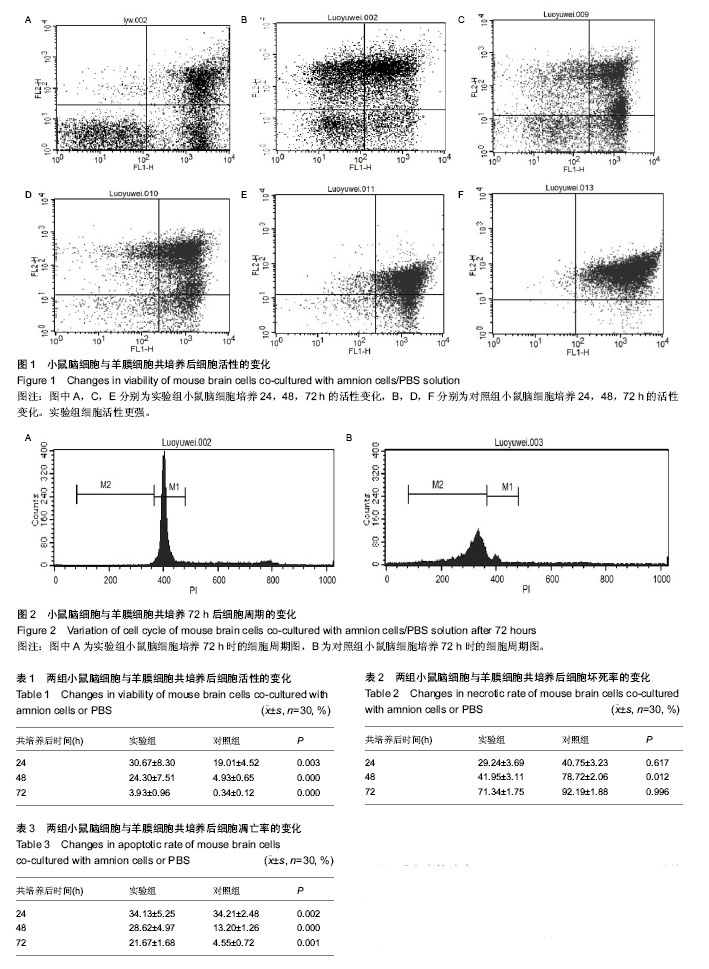| [1] 中华医学会神经病学分会脑血管病学组"卒中一级预防指南"撰写组.中国卒中一级预防指南(2010)[J].柳州医学,2012,25(3): 149-153.
[2] 陈娟燕.银杏达莫注射液治疗急性脑梗死42例[J].浙江中医杂志, 2012,47(3):224.
[3] 喻皇飞,陈代雄.人羊膜细胞神经生物学性状研究进展[J].重庆医学,2011,40(32):3315-3317.
[4] 朴正福,张海燕,丁淑芹,等.羊膜干细胞分离方法及其细胞学特性鉴定[J].透析与人工器官,2009(1):1-5.
[5] 高振,罗晓婷,邓炜,等.羊膜与羊膜细胞外基质在组织工程中的应用[J].中国组织工程研究与临床康复,2007,11(32):6450-6453.
[6] 李端庄,梁轩伟,严灿荣,等.羊膜细胞培养液对体外培养视网膜组织中一氧化氮及合成酶的影响[J].中华眼底病杂志,2004,20(6): 366-368.
[7] 刘斌,田新良,王晓雯,等.羊膜细胞对帕金森病鼠纹状体中残存多巴胺神经元的营养作用[J].解剖与临床,1999,4(4):194-196.
[8] 吴智运,卢奕,惠国桢,等.人羊膜细胞移植治疗大鼠脊髓损伤的实验研究[J].中华神经外科杂志,2006,22(9):572-574.
[9] 刘斌,田新良,王晓雯,等.羊膜细胞移植对帕金森病鼠纹状体中多巴胺神经元的促再生作用[J].中国老年学杂志,2001, 21(9): 358-360.
[10] 刘斌,田新良,管兴志,等.帕金森病鼠纹状体内羊膜移植对C-fos表达的影响[J].中国临床神经外科杂志,1999,4(5):33-34.
[11] Chen J, Zhang C, Jiang H, et al. Atorvastatin induction of VEGF and BDNF promotes brain plasticity after stroke in mice. J Cereb Blood Flow Metab. 2005;25(2):281-290.
[12] 方宁,张路,宋秀军,等.人羊膜间充质干细胞的分离、培养及鉴定[J].遵义医学院学报,2009,32(3):234-236.
[13] 朱梅,陈东,孟晓婷,等.羊膜上皮细胞移植治疗帕金森病大鼠的实验研究[J].中国老年医学杂志,2006,26(2):227-229.
[14] Kakishita K, Nakao N, Sakuragawa N, et al. Implantation of human amniotic epithelial cells prevents the degeneration of nigral dopamine neurons in rats with 6-hydroxydopamine lesions. Brain Res. 2003;980(1):48-56.
[15] Barker RA, Dunnett SB, Faissner A, et al. The time course of loss of dopaminergic neurons and the gliotic reaction surrounding grafts of embryonic mesencephalon to the striatum. Exp Neurol. 1996;141(1):79-93.
[16] Nakao N, Shintani-Mizushima A, Kakishita K, et al. Transplantation of autologous sympathetic neurons as a potential strategy to restore metabolic functions of the damaged nigrostriatal dopamine nerve terminals in Parkinson's disease. Brain Res Rev. 2006;52(2):244-256.
[17] Brundin P, Karlsson J, Emgård M, et al. Improving the survival of grafted dopaminergic neurons: a review over current approaches. Cell Transplant. 2000;9(2):179-195.
[18] Ziv I, Offen D, Barzilai A, et al. Modulation of control mechanisms of dopamine-induced apoptosis--a future approach to the treatment of Parkinson's disease? J Neural Transm Suppl. 1997;49:195-202.
[19] Ziv I, Barzilai A, Offen D, et al. Nigrostriatal neuronal death in Parkinson's disease--a passive or an active genetically-controlled process? J Neural Transm Suppl. 1997; 49:69-76.
[20] Ueda S, Sakakibara S, Watanabe E, et al. Vulnerability of monoaminergic neurons in the brainstem of the zitter rat in oxidative stress. Prog Brain Res. 2002;136:293-302.
[21] González-Hernández T, Afonso-Oramas D, Cruz-Muros I. Phenotype, compartmental organization and differential vulnerability of nigral dopaminergic neurons. J Neural Transm Suppl. 2009;(73):21-37.
[22] Prasad KN, Clarkson ED, La Rosa FG, et al. Efficacy of grafted immortalized dopamine neurons in an animal model of parkinsonism: a review. Mol Genet Metab. 1998;65(1):1-9.
[23] Mena MA, de Bernardo S, Casarejos MJ, et al. The role of astroglia on the survival of dopamine neurons. Mol Neurobiol. 2002;25(3):245-263.
[24] Ebendal T, Lönnerberg P, Pei G, et al. Engineering cells to secrete growth factors. J Neurol. 1994;242(1 Suppl 1):S5-7.
[25] Sun E. Cell death recognition model for the immune system. Med Hypotheses. 2008;70(3):585-596.
[26] Liu J, Li J, Yang Y, et al. Neuronal apoptosis in cerebral ischemia/reperfusion area following electrical stimulation of fastigial nucleus. Neural Regen Res. 2014;9(7):727-734.
[27] Minina EA, Bozhkov PV, Hofius D. Autophagy as initiator or executioner of cell death. Trends Plant Sci. 2014. in press.
[28] Wei B, Yue P, Qingwei L. The molecular mechanism of necroptosis. Yi Chuan. 2014;36(6):519-524.
[29] Wang K. Molecular mechanisms of liver injury: Apoptosis or necrosis. Exp Toxicol Pathol. 2014;66(8):351-356.
[30] Beesoo R, Neergheen-Bhujun V, Bhagooli R, et al. Apoptosis inducing lead compounds isolated from marine organisms of potential relevance in cancer treatment. Mutat Res Fundam Mol Mech Mutagen. 2014. in press.
[31] Cerella C, Teiten MH, Radogna F, et al. From nature to bedside: Pro-survival and cell death mechanisms as therapeutic targets in cancer treatment. Biotechnol Adv. 2014; 32(6):1111-1122.
[32] Tian XF, Cui MX, Yang SW, et al. Cell death, dysglycemia and myocardial infarction. Biomed Rep. 2013;1(3):341-346.
[33] Kim SH, Choi KC. Anti-cancer Effect and Underlying Mechanism(s) of Kaempferol, a Phytoestrogen, on the Regulation of Apoptosis in Diverse Cancer Cell Models. Toxicol Res. 2013;29(4):229-234.
[34] Li ZM, Chu FL, Liu Y, et al. Progress on mechanism of cell apoptosis induced by rubella virus. Bing Du Xue Bao. 2013; 29(5):578-582.
[35] Reyjal J, Cormier K, Turcotte S. Autophagy and cell death to target cancer cells: exploiting synthetic lethality as cancer therapies. Adv Exp Med Biol. 2014;772:167-188.
[36] Bincoletto C, Bechara A, Pereira GJ, et al. Interplay between apoptosis and autophagy, a challenging puzzle: new perspectives on antitumor chemotherapies. Chem Biol Interact. 2013;206(2):279-288.
[37] Zimmerman MA, Huang Q, Li F, et al. Cell death-stimulated cell proliferation: a tissue regeneration mechanism usurped by tumors during radiotherapy. Semin Radiat Oncol. 2013; 23(4):288-295.
[38] 杨春,李维佳,史明霞.人羊膜组织及羊膜干细胞的研究进展[J].医学研究杂志,2008,37(10):13-15. |

